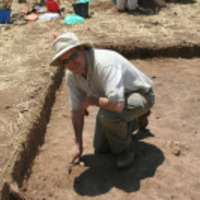Papers by Charles Lindsay

Open-File Report, 2007
Conglomerate and sandstone (Holocene)-Alluvium: shingly and detrital sediments, gravel, sand more... more Conglomerate and sandstone (Holocene)-Alluvium: shingly and detrital sediments, gravel, sand more abundant than silt and clay Conglomerate and sandstone (Holocene and late Pleistocene)-Alluvium: shingly and detrital sediments, gravel, sand more abundant than silt and clay Eolian deposits (Holocene and late Pleistocene)-Sand Fan alluvium and colluvium (Holocene and late Pleistocene)-Fan alluvium and colluvium: shingly and detrital sediments, gravel, sand, clay Conglomerate and sandstone (late Pleistocene)-Alluvium: shingly and detrital sediments, gravel, sand more abundant than silt and clay Conglomerate and sandstone (middle Pleistocene)-Alluvium: shingly and detrital sediments, gravel, sand more abundant than silt and clay Loess (middle Pleistocene)-Loess more abundant than sand, clay Conglomerate and sandstone (early Pleistocene)-Alluvium: shingly and detrital sediments, gravel, sand more abundant than silt and clay Andesite tuff (early Pleistocene)-Andesite, dacite tuff and welded tuff (Dashtinovar Series) Conglomerate and sandstone (late Pliocene)-Gray conglomerate, grit, sandstone more abundant than siltstone, clay, limestone, marl; gypsum, salt; acid to mafic volcanic rocks Sandstone and conglomerate (early Pliocene)-Variegated sandstone, conglomerate more abundant than clay, siltstone Conglomerate and sandstone (late Miocene)-Variegated conglomerate, sandstone more abundant than grit, clay, siltstone Clay and siltstone (middle Miocene)-Brown clay, siltstone more abundant than sandstone, conglomerate, limestone Clay and siltstone (early Miocene)-Red clay, siltstone more abundant than sandstone, conglomerate, limestone Clay and shale (Eocene)-Clay, shale, siltstone more abundant than sandstone, limestone, marl, gypsum, conglomerate Limestone and dolomite (Paleocene and Late Cretaceous)-Limestone, marl, dolomite more abundant than sandstone, clay, siltstone, gypsum, conglomerate Sandstone and siltstone (Late Cretaceous)-Sandstone, siltstone more abundant than clay, limestone, marl, conglomerate, gypsum Sandstone and conglomerate (Early Cretaceous)-Red sandstone, conglomerate more abundant than siltstone, gypsum, clay Conglomerate and sandstone (Late Jurassic)-Conglomerate, sandstone more abundant than siltstone, clay, limestone, gypsum Sandstone and siltstone (Middle and Early Jurassic)-Sandstone, siltstone more abundant than clay, conglomerate, coal Granodiorite and granosyenite (Late Triassic)-Granodiorite, granosyenite, granophyre, granite Andesite and granite porphyry (Late Triassic)-Andesite porphyry, granite porphyry Rhyolite lava (Late Triassic (Rhaetian))-Rhyolite and andesite more abundant than sandstone, mudstone, conglomerate, grit Sandstone and siltstone (Late and Middle Triassic)-Sandstone and siltstone more abundant than mudstone, carbonaceous shale, limestone, marl, conglomerate, acid and mafic volcanic rocks Granite (Early Triassic)-Granite (Phase III) Limestone and sandstone (Early Permian)-Includes Uluk and Kuberghandian horizons; limestone and sandstone more abundant than siltstone, conglomerate Limestone (Late Carboniferous)-Limestone more abundant than slate, sandstone, conglomerate, siltstone, andesite to basalt volcanic rocks Diorite and granodiorite (Early Carboniferous)-Diorite, granodiorite more abundant than granophyre, plagiogranite Basalt and sandstone (Early Carboniferous (Namurian))-Basalt, sandstone, siltstone, shale

The papers in this volume represent the second annual report of archaeological investiagions carr... more The papers in this volume represent the second annual report of archaeological investiagions carried out within the province of Nova Scotia. They are preliminary statements of research results required under the terms of the Special Places protections Act (1980). Topics covered include: Report on the chambers fluted point preform Report on preliminary archaeological exploration of the foundry north area, Nova Scotia Museum of Industry, 1987 Locomotive house, Stellarton The Stellarton pumphouse Preliminary excavations at a nineteenth century foundry Summary report (1987) Excavation at White's Lake, 1987 Yarmouth coastal survey St. John's Anglican Church, Preston Salvage archaeology at the engineer's property, Louisburg The Dimock House Summary report (1988) Prelimary excavation of the Albion Iron Foundry Grassy Island: Submerged cultural resource survey 1988 Preliminary report on the Bain site and the Chegoggin archaeological project Reconnaissances prelliminaires du site...
The Curatorial Reports of the Nova Scotia Museum contain information on the collections and the p... more The Curatorial Reports of the Nova Scotia Museum contain information on the collections and the preliminary results of research projects carried out under the program of the Museum. The Reports may be cited in publications but their manuscript status should be clearly indicated. The Editors would like to acknowledge the efforts of Mrs •. Robert. ~ Wittmann, Department of Anthropology, Saint Mary's University who word processed this report. ii 1 l l 1 l l
Curatorial Reports The Curatorial Reports of the Nova Scotia Museum contain information on the co... more Curatorial Reports The Curatorial Reports of the Nova Scotia Museum contain information on the colledions and the preliminary results of research projects carried out under the program of the Museum. The Reports may be cited in publications but their manuscript status should be clearly Indicated. i l/ 1 l T l 1

Nature
Transatlantic exploration took place centuries before the crossing of Columbus. Physical evidence... more Transatlantic exploration took place centuries before the crossing of Columbus. Physical evidence for early European presence in the Americas can be found in Newfoundland, Canada1,2. However, it has thus far not been possible to determine when this activity took place3–5. Here we provide evidence that the Vikings were present in Newfoundland in ad 1021. We overcome the imprecision of previous age estimates by making use of the cosmic-ray-induced upsurge in atmospheric radiocarbon concentrations in ad 993 (ref. 6). Our new date lays down a marker for European cognisance of the Americas, and represents the first known point at which humans encircled the globe. It also provides a definitive tie point for future research into the initial consequences of transatlantic activity, such as the transference of knowledge, and the potential exchange of genetic information, biota and pathologies7,8.
Nova Scotia Museum, 1991
The Chambers fluted point preform was found by Adam Chambers while playing in his yard at 19 Plym... more The Chambers fluted point preform was found by Adam Chambers while playing in his yard at 19 Plymouth Street, Dartmouth. Adam found the preform near the surface of the ground while playing with a friend in the northwest comer of the backyard.
Recent and Most-Cited Papers by Charles Lindsay










Uploads
Papers by Charles Lindsay
Recent and Most-Cited Papers by Charles Lindsay